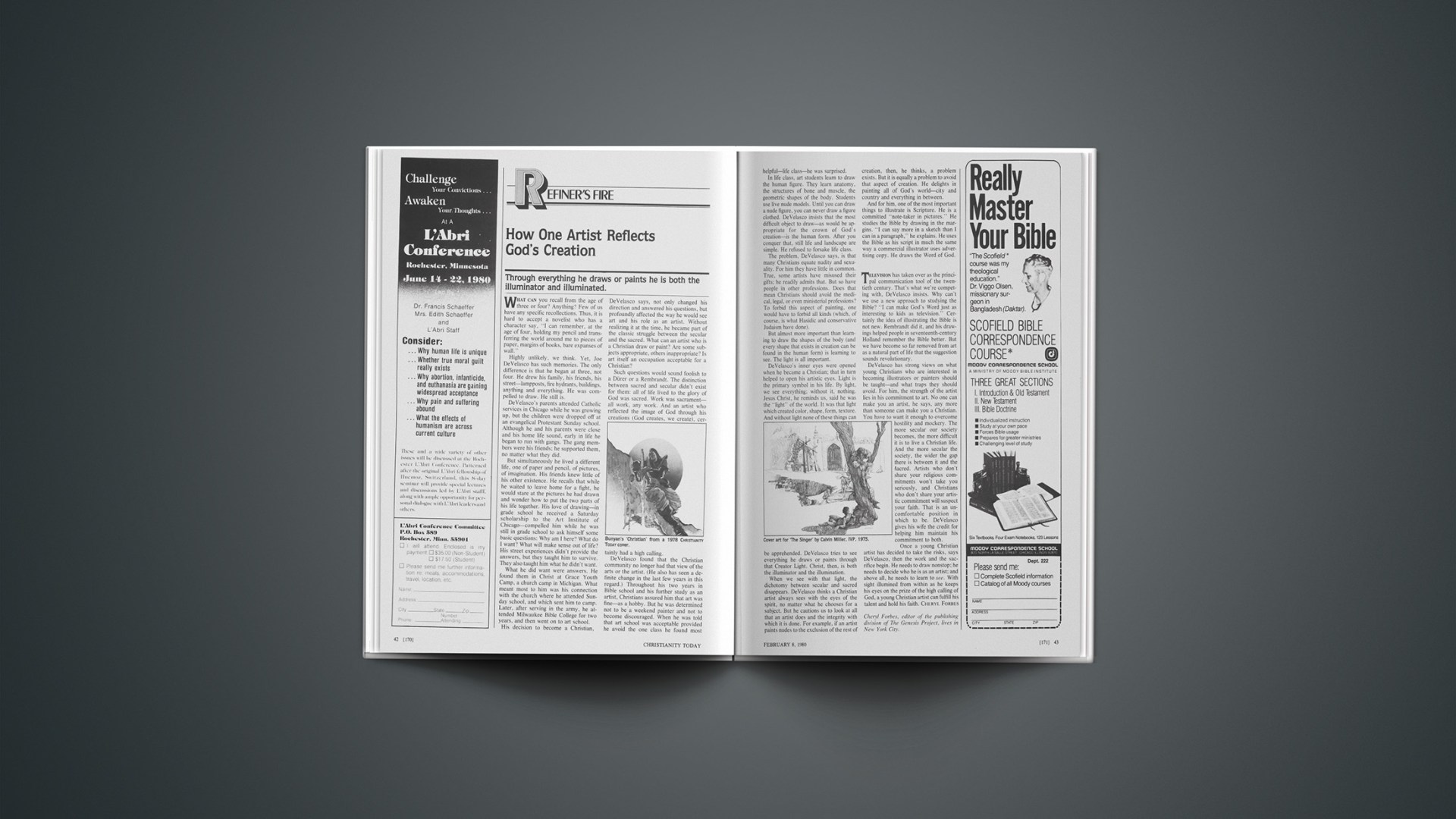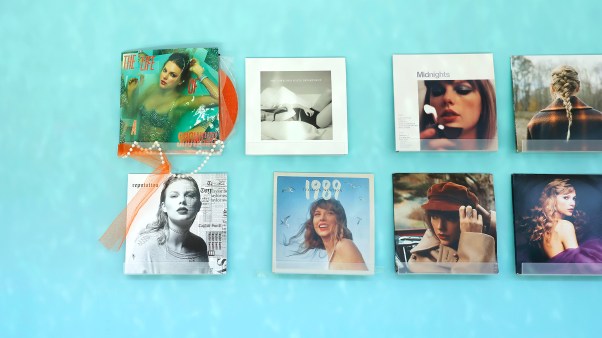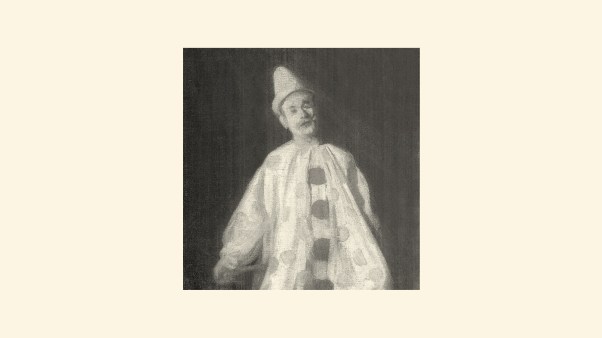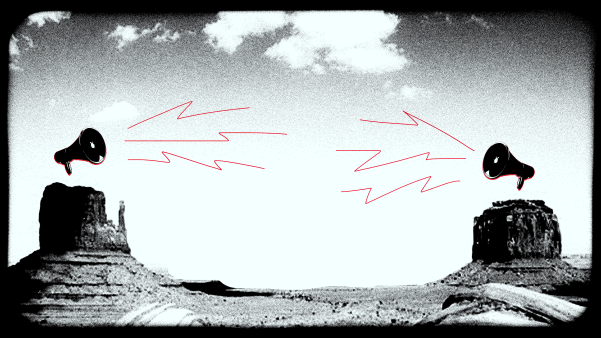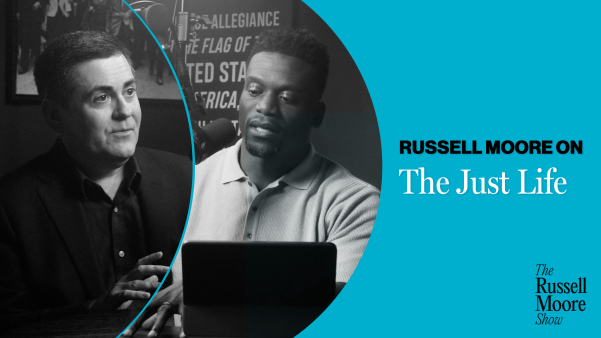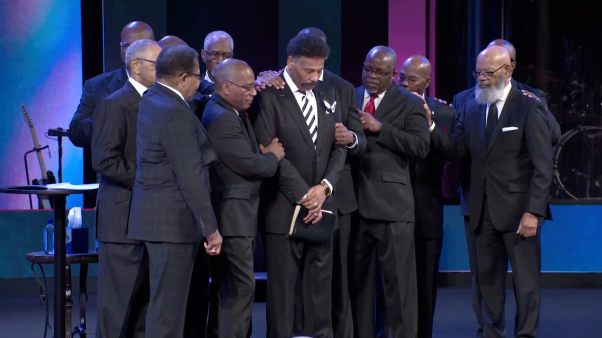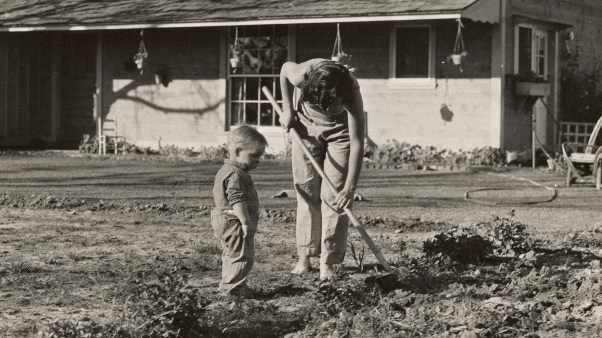Through everything he draws or paints he is both the illuminator and illuminated.
What can you recall from the age of three or four? Anything? Few of us have any specific recollections. Thus, it is hard to accept a novelist who has a character say, “I can remember, at the age of four, holding my pencil and transferring the world around me to pieces of paper, margins of books, bare expanses of wall.”
Highly unlikely, we think. Yet, Joe DeVelasco has such memories. The only difference is that he began at three, not four. He drew his family, his friends, his street—lampposts, fire hydrants, buildings, anything and everything. He was compelled to draw. He still is.
DeVelasco’s parents attended Catholic services in Chicago while he was growing up, but the children were dropped off at an evangelical Protestant Sunday school. Although he and his parents were close and his home life sound, early in life he began to run with gangs. The gang members were his friends; he supported them, no matter what they did.
But simultaneously he lived a different life, one of paper and pencil, of pictures, of imagination. His friends knew little of his other existence. He recalls that while he waited to leave home for a fight, he would stare at the pictures he had drawn and wonder how to put the two parts of his life together. His love of drawing—in grade school he received a Saturday scholarship to the Art Institute of Chicago—compelled him while he was still in grade school to ask himself some basic questions: Why am I here? What do I want? What will make sense out of life? His street experiences didn’t provide the answers, but they taught him to survive. They also taught him what he didn’t want.
What he did want were answers. He found them in Christ at Grace Youth Camp, a church camp in Michigan. What meant most to him was his connection with the church where he attended Sunday school, and which sent him to camp. Later, after serving in the army, he attended Milwaukee Bible College for two years, and then went on to art school.
His decision to become a Christian, DeVelasco says, not only changed his direction and answered his questions, but profoundly affected the way he would see art and his role as an artist. Without realizing it at the time, he became part of the classic struggle between the secular and the sacred. What can an artist who is a Christian draw or paint? Are some subjects appropriate, others inappropriate? Is art itself an occupation acceptable for a Christian?
Such questions would sound foolish to a Dürer or a Rembrandt. The distinction between sacred and secular didn’t exist for them: all of life lived to the glory of God was sacred. Work was sacrament—all work, any work. And an artist who reflected the image of God through his creations (God creates, we create), certainly had a high calling.
DeVelasco found that the Christian community no longer had that view of the arts or the artist. (He also has seen a definite change in the last few years in this regard.) Throughout his two years in Bible school and his further study as an artist, Christians assured him that art was fine—as a hobby. But he was determined not to be a weekend painter and not to become discouraged. When he was told that art school was acceptable provided he avoid the one class he found most helpful—life class—he was surprised.
In life class, art students learn to draw the human figure. They learn anatomy, the structures of bone and muscle, the geometric shapes of the body. Students use live nude models. Until you can draw a nude figure, you can never draw a figure clothed. DeVelasco insists that the most difficult object to draw—as would be appropriate for the crown of God’s creation—is the human form. After you conquer that, still life and landscape are simple. He refused to forsake life class.
The problem, DeVelasco says, is that many Christians equate nudity and sexuality. For him they have little in common. True, some artists have misused their gifts; he readily admits that. But so have people in other professions. Does that mean Christians should avoid the medical, legal, or even ministerial professions? To forbid this aspect of painting, one would have to forbid all kinds (which, of course, is what Hasidic and conservative Judaism have done).
But almost more important than learning to draw the shapes of the body (and every shape that exists in creation can be found in the human form) is learning to see. The light is all important.
DeVelasco’s inner eyes were opened when he became a Christian; that in turn helped to open his artistic eyes. Light is the primary symbol in his life. By light, we see everything; without it, nothing. Jesus Christ, he reminds us, said he was the “light” of the world. It was that light which created color, shape, form, texture. And without light none of these things can be apprehended. DeVelasco tries to see everything he draws or paints through that Creator Light. Christ, then, is both the illuminator and the illumination.
When we see with that light, the dichotomy between secular and sacred disappears. DeVelasco thinks a Christian artist always sees with the eyes of the spirit, no matter what he chooses for a subject. But he cautions us to look at all that an artist does and the integrity with which it is done. For example, if an artist paints nudes to the exclusion of the rest of creation, then, he thinks, a problem exists. But it is equally a problem to avoid that aspect of creation. He delights in painting all of God’s world—city and country and everything in between.
And for him, one of the most important things to illustrate is Scripture. He is a committed “note-taker in pictures.” He studies the Bible by drawing in the margins. “I can say more in a sketch than I can in a paragraph,” he explains. He uses the Bible as his script in much the same way a commercial illustrator uses advertising copy. He draws the Word of God.
Television has taken over as the principal communication tool of the twentieth century. That’s what we’re competing with, DeVelasco insists. Why can’t we use a new approach to studying the Bible? “I can make God’s Word just as interesting to kids as television.” Certainly the idea of illustrating the Bible is not new. Rembrandt did it, and his drawings helped people in seventeenth-century Holland remember the Bible better. But we have become so far removed from art as a natural part of life that the suggestion sounds revolutionary.
DeVelasco has strong views on what young Christians who are interested in becoming illustrators or painters should be taught—and what traps they should avoid. For him, the strength of the artist lies in his commitment to art. No one can make you an artist, he says, any more than someone can make you a Christian. You have to want it enough to overcome hostility and mockery. The more secular our society becomes, the more difficult it is to live a Christian life. And the more secular the society, the wider the gap there is between it and the sacred. Artists who don’t share your religious commitments won’t take you seriously, and Christians who don’t share your artistic commitment will suspect your faith. That is an uncomfortable position in which to be. DeVelasco gives his wife the credit for helping him maintain his commitment to both.
Once a young Christian artist has decided to take the risks, says DeVelasco, then the work and the sacrifice begin. He needs to draw nonstop; he needs to decide who he is as an artist; and above all, he needs to learn to see. With sight illumined from within as he keeps his eyes on the prize of the high calling of God, a young Christian artist can fulfill his talent and hold his faith.
Cheryl Forbes, editor of the publishing division of The Genesis Project, lives in New York City.

